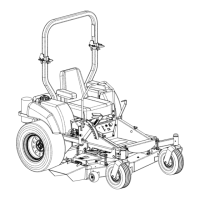
Do you have a question about the Husqvarna iZ4821KAA, iZ5223KAA, iZ5223TKOA, iZ4217TSKAA, iZ4817TSKAA, iZ6123KAA and is the answer not in the manual?
| Transmission Type | Hydrostatic |
|---|---|
| Engine Brand | Kawasaki, Briggs & Stratton |
| Model | iZ4821KAA, iZ5223KAA, iZ5223TKOA, iZ4217TSKAA, iZ4817TSKAA, iZ6123KAA |
| Cutting Height Range | 1.5-4.5 inches |
| Deck Type | Fabricated |
General terms, driving directions, and operating principles used in the manual.
Guidelines for operating the mower on public roads and during transport.
Proper usage guidelines for the machine to ensure efficiency and safety.
Information regarding Husqvarna's service network and customer support.
Location and importance of manufacturing, model, and serial numbers.
Explanation of warning symbols indicating risks of personal injury.
Explanation of symbols indicating risks of material damage or caution.
Basic safety rules for operating the mower, including area preparation.
Warnings related to exhaust fumes, hot components, and battery hazards.
Requirements for using appropriate personal protective equipment during operation.
Specific safety precautions and techniques for operating on inclines.
Guidelines to ensure child safety around the mower during operation.
Safety measures to follow during maintenance procedures, including refueling.
Safety precautions for refueling and engine operation, avoiding heat and sparks.
Precautions for handling and servicing the battery, noting chemical hazards.
Warnings about enclosed spaces, repairs, and general transport safety.
Guidelines for safely transporting the mower onto vehicles and trailers.
Safety guidelines and warnings related to the ROPS structure.
Owner's duties for safe operation, maintenance, and adherence to safety rules.
Diagram identifying key external parts and controls of the mower.
Step-by-step instructions for assembling the Roll Over Protection System.
Instructions for checking and setting the correct tire pressure.
Adjusting the control arms for proper neutral position and operation.
Instructions for installing the seat and armrests onto the mower.
Procedure for checking and maintaining the engine oil level.
Steps for installing the mower deck discharge chute.
How to set the desired cutting height for mowing.
Procedure for ensuring the mower deck is properly leveled for optimal performance.
Adjusting the tension of the throttle lever for responsive control.
Steps for adjusting the park brake mechanism for proper function.
Adjusting the motion control linkage for proper forward and reverse movement.
Detailed procedure for fine-tuning motion control linkage for neutral operation.
Instructions for operating with the roll bar raised and seat belt secured.
Steps for starting the engine and performing basic machine operation.
Explanation of how motion control levers operate the machine's direction and speed.
How to adjust the tracking knob for straight-line travel with control levers forward.
Operation of blade engagement switch and choke control.
How to use the throttle, parking brake lever, and key switch.
Understanding the hour meter alerts and fuel shut-off valve operation.
Daily checks and specifications for engine oil.
Procedures for inspecting, sharpening, and replacing mower blades.
Maintenance for cutter housings and safety interlock system checks.
Regular checks for loose hardware and air filter condition.
Checking hydraulic oil level, changing oil, and bleeding air.
How to inspect and replace the mower deck belt.
Checking and replacing the pump belt for wear.
Identifying lubrication points and intervals from the service decal.
Checking tire pressure and adjusting caster wheels.
Procedure for replacing the fuel filter at specified intervals.
Steps for preparing the machine for winter storage, including cleaning and oiling.
List of torque values for various fasteners on the mower.
Table outlining maintenance tasks by daily, 25, 50, 100, 200, 250, and 500 hour intervals.
Troubleshooting common problems with engine starting and machine movement.
Solutions for blade engagement problems and uneven or ragged cut quality.
Diagnosing and resolving machine vibration issues.
Wiring diagram for starter, brake, and run relays and motion control levers.
Wiring for key switch positions, hour meter, and accessory outlet.
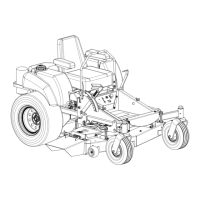


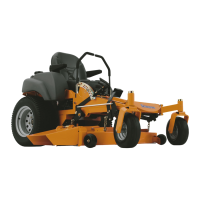


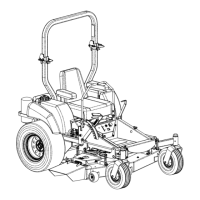




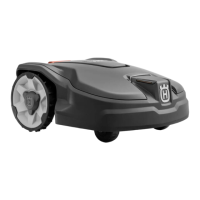
